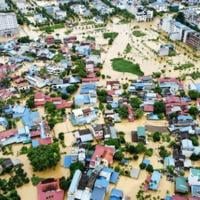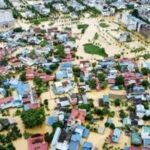Many individuals throughout Southeast Asia are facing challenges on Thursday due to flooded homes, power outages, and damaged infrastructure following the passage of Typhoon Yagi. The death toll has surpassed 200.
In Vietnam, the number of fatalities reached 197, with nine confirmed deaths in northern Thailand, where one district is experiencing its worst flooding in 80 years.
Typhoon Yagi made landfall in Vietnam over the weekend, causing heavy rainfall that has flooded parts of northern Vietnam, Laos, Thailand, and Myanmar, leading to deadly landslides and extensive river flooding.
One farmer shared with AFP that his entire 1,800 square meter peach blossom plantation was submerged, resulting in the destruction of all 400 trees.
Without disclosing his name, the farmer mentioned, “It will be incredibly difficult for me to recover from this loss – I anticipate losing up to $40,000 this season. I’m unsure of what to do next; I’m simply waiting for the water to recede.”
UNICEF reported that the typhoon damaged over 140,000 homes across 26 provinces in Vietnam. They have supplied water to homes, health facilities, and schools in the hardest-hit areas and will be sending medical and sanitation supplies to the Vietnamese government soon.
– Disrupted Communications –
The excessive flooding has destroyed more than 250,000 hectares of crops and a significant amount of livestock, according to Vietnam’s agriculture ministry, with farmlands around Hanoi bearing the brunt.
In certain parts of the Vietnamese capital, commuters waded through knee-deep floodwaters to get to work. Officials mentioned that river levels in the city are slowly receding after reaching a 20-year peak on Wednesday.
Thousands have been evacuated from their homes, while others are struggling with power interruptions. In one severely affected district on the outskirts of Hanoi, over 15,000 individuals have been impacted by the floods.
State media in Vietnam reported a landslide in the mountainous Lao Cai province that resulted in seven deaths and 11 individuals still missing. The incident occurred on Tuesday, but details reached the authorities late due to communication disruptions in the area.
In addition, a separate landslide in the same province wiped out an entire village of 37 houses, leading to at least 42 fatalities and 53 individuals still unaccounted for.
Following a landslide in Cao Bang province, 15 bodies were recovered after a bus, along with several cars and motorbikes, was swept into a stream on Monday, as per state media reports on Thursday.
– Luang Prabang Alert –
The Mekong River Commission issued a flood warning on Thursday for the historic Laotian city of Luang Prabang. The Mekong is projected to reach flood levels in Luang Prabang on Thursday, a UNESCO world heritage site, as per the commission’s bulletin.
In Thailand, the death toll has climbed to nine, with the Department of Disaster Prevention and Mitigation reporting six fatalities in landslides in Chiang Mai province. Flights to the airport in Chiang Rai have been suspended, aviation authorities stated.
Mae Sai district on the border with Myanmar is facing its worst floods in 80 years, as confirmed by Suttipong Juljarern, a senior official from the interior ministry. Prime Minister Paetongtarn Shinawatra has directed supplies to be sent to the affected regions and mobilized the military to provide boats, helicopters, and other transport for relief operations.
Buddhist temples, hotels, and resorts have opened their doors to accommodate nearly 1,000 people displaced by the floods, the government announced.
In Myanmar, flooding is severe around the low-lying capital Naypyidaw due to heavy monsoon rains. The town of Taungoo is also under threat from rising river levels. The state-run newspaper, The Global New Light of Myanmar, reported that train services on the main line between Yangon and Mandalay were halted due to flooding in some sections.
While heavy monsoon rains are common in Southeast Asia, human-induced climate change is contributing to more intense weather patterns, increasing the likelihood of destructive floods. According to a July study, climate change is causing typhoons to form closer to the coast, intensify rapidly, and linger longer over land.
burs-pdw/rsc





